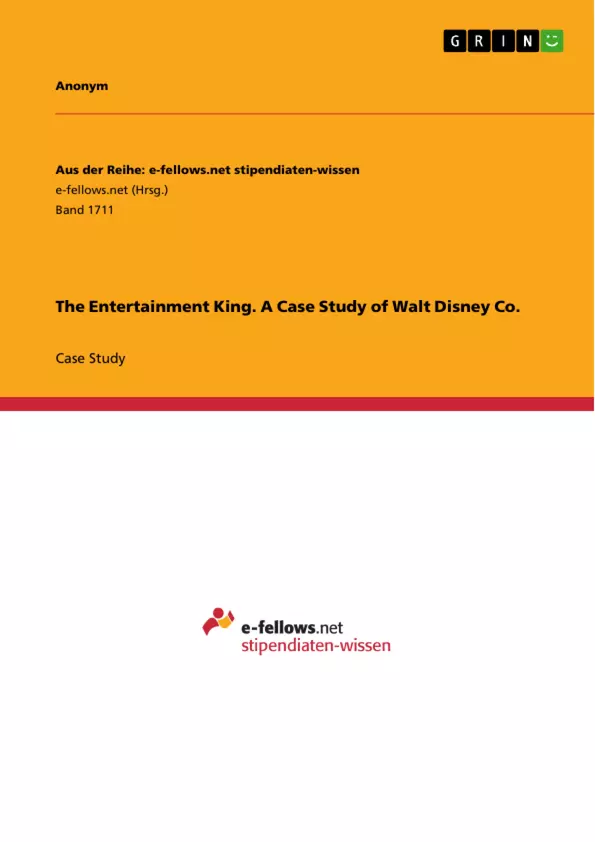The following paper is an analysis about Walt Disney. It is an investigation about the business model of the Walt Disney company and its objective is to turn out the characteristics in terms of values and strategies, which made the company to that what it is today- one of the most successful companies and well-known brands in the world.
In the first part of the paper we want to examine why Disney has been successful for so long and explain thereby what its core competences and competitive advantages are. In the second section we will have a look on what Michael Eisner did to rejuvenate Disney and what he did to increase the income in his first for years. Finally, in the last part we will evaluate Disney’s policy of acquisitions, define the value they are adding to their different divisions and conclude with the explanation about how that translates into financial performance.
Table of Contents
- Introduction
- The business model of Disney
- Business Model Canvas
- Key Partners
- Key Resources
- Key Activities
- Value Proposition
- Cost Structure
- Channels
- Customer Segments
- Customer Relationships
- Revenue Streams
- Media Networks (Total revenue: USD 21,152)
- Parks & Resorts (Total revenue: USD 15,099)
- Studio Entertainment (Total revenue: USD 7,278)
- Consumer Products: (Total revenue: USD 3,985)
- Interactive: (Total revenue: USD 1,299)
- Core Competencies & Competitive Advantage
- Business Model Canvas
- Rejuvenation of Disney between 1984 and 1988 und Michael Eisner
- Values and competitive advantage of Walt Disney
- Pixar
- Marvel
- Lucasfilm
- Biography
Objectives and Key Themes
This paper examines the business model of The Walt Disney Company, investigating its values and strategies that have contributed to its success as a global brand. The paper aims to understand the core competencies and competitive advantages that have led to Disney's enduring success. It will also explore Michael Eisner's role in rejuvenating Disney and increasing its revenue, as well as evaluate Disney's acquisition strategy and its impact on financial performance.
- The evolution of Disney's business model and its core competencies.
- Michael Eisner's contribution to Disney's rejuvenation and revenue growth.
- Disney's acquisition strategy and its impact on different divisions.
- The relationship between Disney's values and its competitive advantage.
- The financial performance of Disney's various business segments.
Chapter Summaries
- Introduction: This chapter introduces the paper's focus on analyzing The Walt Disney Company's business model and its success as a global brand. It outlines the paper's objectives, including examining Disney's core competencies, exploring Michael Eisner's rejuvenation efforts, and evaluating the impact of acquisitions.
- The business model of Disney: This chapter delves into Disney's business model through the lens of the Business Model Canvas. It explores key aspects such as key partners, key resources, key activities, value proposition, cost structure, channels, customer segments, and customer relationships, providing a comprehensive overview of how Disney operates.
- Revenue Streams: This chapter breaks down Disney's revenue streams across its various business segments: Media Networks, Parks & Resorts, Studio Entertainment, Consumer Products, and Interactive. It analyzes the revenue generation strategies and key contributors to each segment's financial success.
- Rejuvenation of Disney between 1984 and 1988 und Michael Eisner: This chapter examines the transformative period under Michael Eisner's leadership, highlighting the strategies and initiatives he implemented to revitalize Disney and increase its revenue. It explores key decisions and their impact on Disney's trajectory.
- Values and competitive advantage of Walt Disney: This chapter delves into the core values that have shaped Disney's identity and contributed to its competitive advantage. It discusses the impact of key acquisitions such as Pixar, Marvel, and Lucasfilm on Disney's overall strategy and brand portfolio.
Keywords
This paper focuses on the business model of The Walt Disney Company, its values and strategies, and its competitive advantage. Key terms and concepts include: business model canvas, core competencies, revenue streams, Michael Eisner, rejuvenation, acquisitions, Pixar, Marvel, Lucasfilm, financial performance, and brand loyalty. The paper examines Disney's evolution as a global brand and its enduring success in the entertainment industry.
- Arbeit zitieren
- Anonym (Autor:in), 2014, The Entertainment King. A Case Study of Walt Disney Co., München, GRIN Verlag, https://www.grin.com/document/315503



